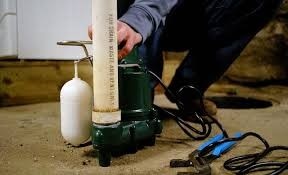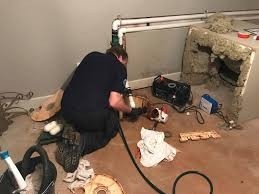The Complete Guide | How to Inspect and Maintain Sump Pumps
- Jeff Hendricks

- Sep 26
- 3 min read
A sump pump is the unsung guardian of your basement—the quiet workhorse standing between you and a flooded floor. Nestled in a pit at the lowest point of your home, it collects groundwater and sends it away before it can creep into walls or flooring. Most days, it hums along unnoticed, a silent sentinel. But here’s the catch: if you ignore it, that same protector could fail right when you need it most—during a downpour or when snow melts in a rush. A little attention now means a lot less panic later.
Regular Inspections
Think of inspections as quick checkups. Every few months, glance inside the pit. Is the pump upright, or has it shifted like a leaning tower ready to cause trouble? A crooked pump can jam the float switch, leaving the system useless. Don’t forget the power source either—always ensure it’s plugged into a grounded outlet with steady electricity. A pump without reliable power is like a firefighter without water.
Testing with Water
The easiest test is also the simplest: add water. Pour a few gallons into the pit until the float rises. The pump should roar—or quietly buzz—into action, sending the water rushing out through the discharge line before shutting itself off. If it sputters, grinds, or refuses to stop, that’s your red flag. Repairs or a replacement might be around the corner.
Cleaning the Sump Pit: Inspect and Maintain Sump Pumps
Mud, gravel, and other debris love to collect at the bottom. Over time, that buildup can choke the pump or wedge the float into place. Every so often, unplug the system, pull it out, and clean the pit. Scrape away sludge, rinse the housing, and make sure the intake screen is clear. A clean pit isn’t just tidier—it keeps the motor from straining itself to death.
Checking the Discharge Line
Your pump is only as good as its exit strategy. The discharge line carries water away, but if it’s clogged, cracked, or frozen in winter, the system fails. Inspect it often.

Water should empty at least 10 to 20 feet from your foundation—far enough that it doesn’t sneak back inside. A simple mesh cover at the outlet keeps leaves, critters, and other debris from turning the pipe into a bottleneck.
Maintaining Backup Systems
Electricity is sump pumps’ lifeblood. Unfortunately, storms—the very reason you need the pump—can kill the power. That’s why a backup system isn’t optional, it’s essential. Battery-powered backups need testing (unplug the main pump to see if they kick in), and their batteries usually expire every few years. Water-powered backups depend on valves and steady pressure, so check those too. Backups aren’t just insurance; they’re peace of mind.
Listening for Warning Signs
Your ears can catch what your eyes miss. A healthy pump is quiet, cycling on only when water rises. If you hear grinding, rattling, or endless running, something’s off—a stuck float, worn motor, or switch failure. Catch the whispers early, and you can inspect and maintain sump pumps effectively.
Replacing Older Pumps
Even the best-maintained pumps don’t last forever. Seven to ten years is the average lifespan. If yours is creeping up on that range, don’t gamble—replace it before it quits mid-storm. Modern models often include alarms, sealed lids to block odors, and even smart monitors that send alerts to your phone. Think of it as upgrading from a pager to a smartphone—it’s the same tool, just smarter and safer.
Professional Maintenance
DIY care goes far, but nothing beats a professional once-over. Once a year, call in a technician to check electrical parts, test the motor, and ensure both the main and backup systems are at full strength. It’s an extra layer of protection, like a second lock on your front door.
A sump pump may be out of sight, but it should never be out of mind. Inspections, cleaning, water tests, discharge checks, and backup maintenance all extend its lifespan. Pair that with a yearly professional checkup, and you’ve built a fortress against basement flooding. A few minutes of care today can save thousands in repairs tomorrow—and guarantee that, no matter the weather, your home stays dry, safe, and secure.






Comments